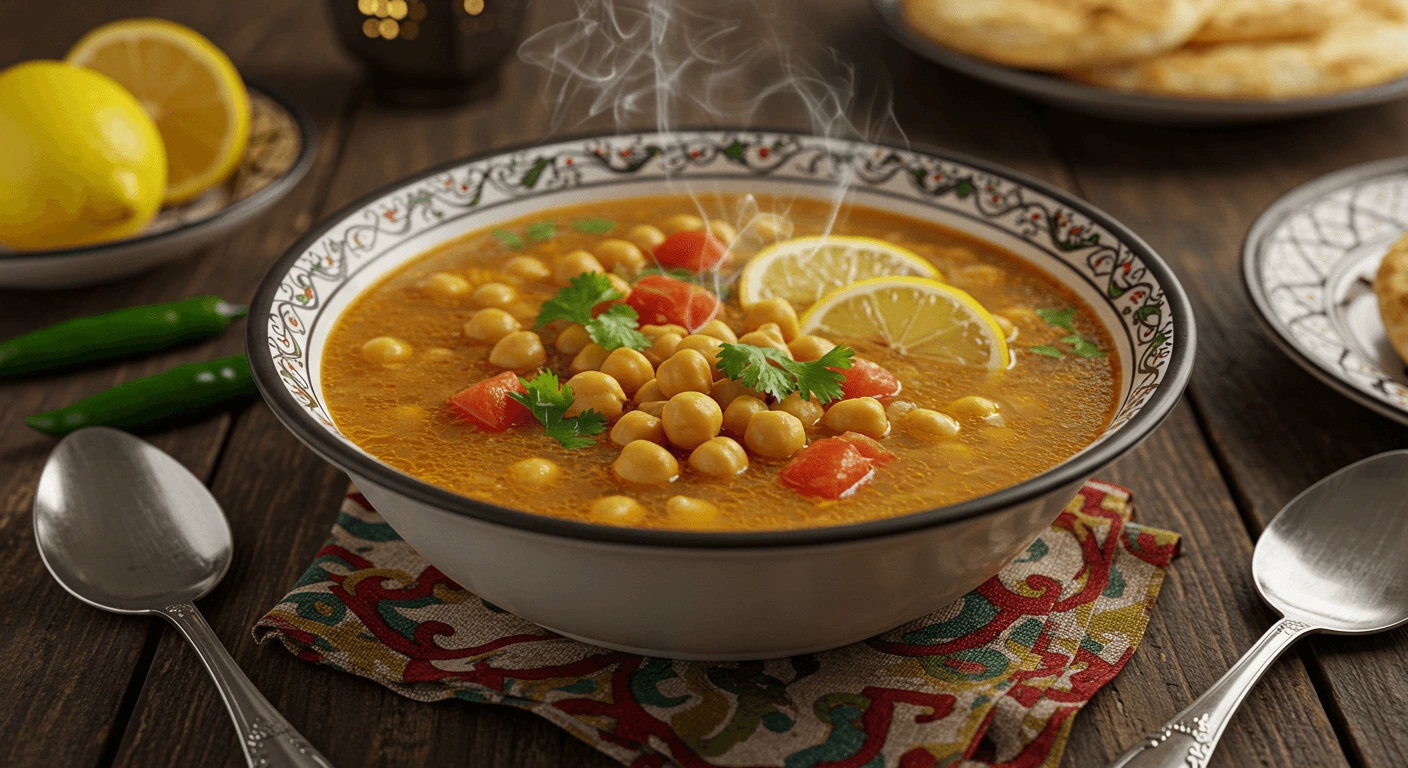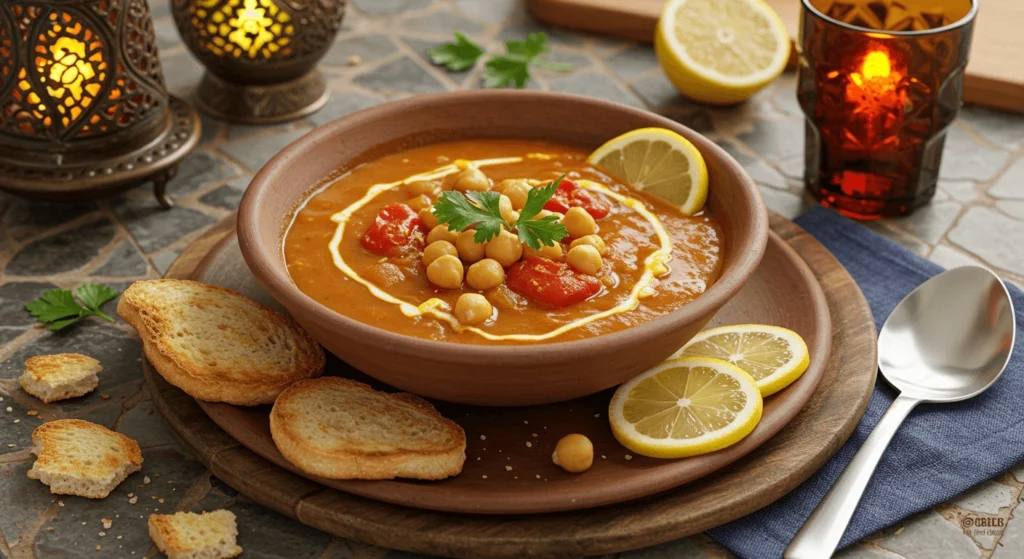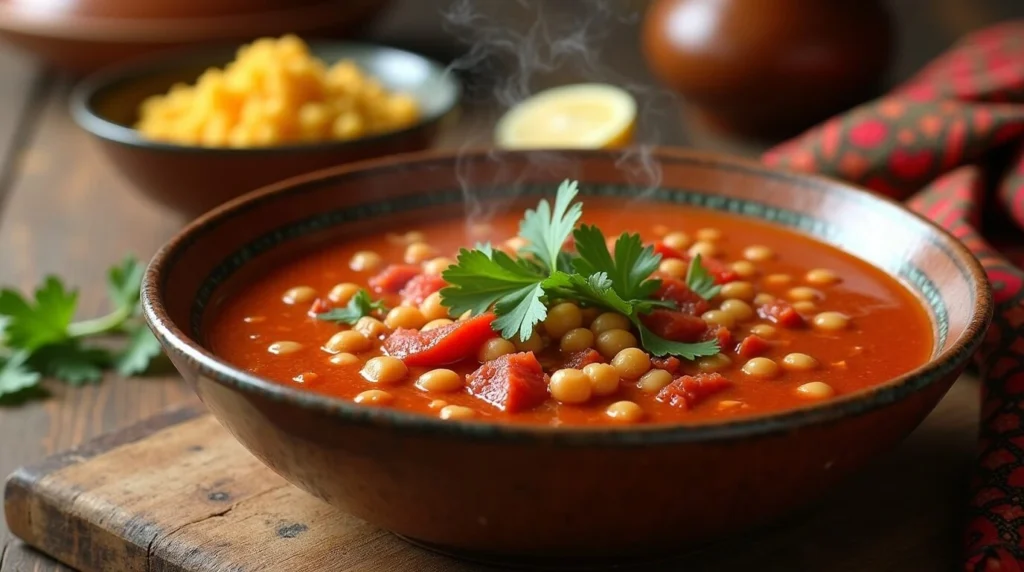
The rich aroma of simmering tomatoes, herbs, and spices fills your kitchen as you prepare one of Morocco’s most beloved dishes. Harira soup represents more than just a meal it’s a cultural tradition that brings families together, especially during Ramadan when breaking the fast becomes a sacred ritual. This hearty, nourishing soup combines protein-packed legumes, tender vegetables, and aromatic spices to create a bowl of pure comfort.
Many home cooks feel intimidated when attempting authentic Moroccan recipes, but mastering harira soup is simpler than you might think. The key lies in understanding the balance of flavors and using the right techniques to develop depth in every spoonful. Whether you’re preparing this soup for a special occasion or wanting to add more international flavors to your weekly meal rotation, this comprehensive guide will teach you professional techniques that guarantee perfect results.
The beauty of harira soup lies in its versatility and nutritional density. Packed with plant-based proteins from lentils and chickpeas, enriched with fresh herbs like cilantro and parsley, and brightened with tomatoes and lemon juice, this soup delivers both satisfaction and health benefits. You’ll discover how proper preparation methods can transform simple ingredients into an extraordinary culinary experience that rivals the best Moroccan restaurants.
Recipe Card Summary
Prep Time: 20 minutes
Cook Time: 45 minutes
Total Time: 1 hour 5 minutes
Servings: 6-8 people
Difficulty: Intermediate
Quick Overview:
- Traditional Moroccan soup perfect for family dinners
- Rich in protein from lentils and chickpeas
- Aromatic blend of warm spices and fresh herbs
- Ideal for meal prep and freezer-friendly
- Naturally vegan with optional meat additions
Key Flavors: Savory, aromatic, slightly tangy with warm spice notes
Best Served: Hot with crusty bread or dates
Storage: Refrigerates for 4 days, freezes for 3 months
Essential Ingredients for Perfect Harira Soup
Base Vegetables and Aromatics
- 2 huge yellow onions, finely diced (approximately 3 cups)
- 4 celery stalks, chopped into small pieces
- 3 large tomatoes, peeled and diced (or 1 can crushed tomatoes)
- 6 garlic cloves, minced
- 2-inch piece fresh ginger, grated
- 2 tablespoons tomato paste for concentrated flavor
Protein-Rich Legumes
- 1 cup dried red lentils, rinsed and sorted
- 1 can (15 oz) chickpeas, drained and rinsed
- 1/2 cup green lentils (optional, for extra texture)
Aromatic Spice Blend
- 1 teaspoon ground cinnamon
- 1 teaspoon ground ginger
- 1/2 teaspoon turmeric powder
- 1 teaspoon ground cumin
- 1/2 teaspoon black pepper
- 1 teaspoon salt (adjust to taste)
- Pinch of saffron threads (optional but authentic)
Fresh Herbs and Finishing Touches
- 1 large bunch fresh cilantro, chopped (about 1 cup)
- 1/2 bunch fresh parsley, chopped
- 2 tablespoons fresh lemon juice
- 3 tablespoons olive oil
- 6-8 cups vegetable or chicken broth
- 2 tablespoons flour mixed with water for thickening
Optional Protein Additions
- 1 pound lamb or beef, cut into small cubes
- 1 chicken breast, diced
- Beef bones for richer broth flavor
Step-by-Step Instructions for Professional Results

Step 1: Prepare Your Mise en Place
Start by organizing all ingredients before cooking begins. Dice onions uniformly to ensure even cooking. Mince garlic and grate fresh ginger using a microplane for the finest texture. Rinse lentils thoroughly under cold running water until the water runs clear. This preparation step prevents any rushed moments during cooking and ensures better flavor development.
Soak saffron threads in 2 tablespoons of warm water if using. This releases the precious aromatic compounds that give harira soup its distinctive golden color and subtle floral notes. The soaking process should take at least 10 minutes for maximum flavor extraction.
Step 2: Build the Flavor Base
Heat olive oil in a expansive, heavy-bottomed pot over medium warm. Add diced onions and cook gradually for 8-10 minutes until they gotten to be translucent and delicately golden. Patience during this step creates the sweet, caramelized foundation that distinguishes exceptional harira soup from ordinary versions.
Add minced garlic and ground ginger to the pot. Cook for another 2 minutes until fragrant, blending always to anticipate burning. The aromatic combination should fill your kitchen with enticing scents that signal the beginning of something special.
Step 3: Develop Deep Tomato Flavor
Stir in tomato paste and cook for 2-3 minutes, allowing it to darken slightly and develop concentrated flavor. This procedure, called “blossoming,” escalate the tomato pith and includes complexity to the wrapped up soup. Add diced fresh tomatoes and cook until they break down and release their juices, approximately 8-10 minutes.
If using canned tomatoes, crush them by hand before adding to maintain rustic texture. The natural acids in tomatoes help break down the lentils during cooking, creating the perfect consistency for authentic harira soup.
Step 4: Toast and Add Spices
Add all ground spices to the tomato mixture and stir continuously for 1-2 minutes. This toasting process awakens the essential oils in the spices and creates deeper, more complex flavors. You’ll notice the mixture becomes incredibly fragrant as the spices bloom in the hot oil and tomato base.
Pour in the saffron water if using, scraping every precious drop from the small bowl. The golden color will begin to develop immediately, giving your harira soup its characteristic appearance.
Step 5: Add Lentils and Liquid
Add rinsed red lentils to the pot and stir to coat with the spice mixture. Pour in 6 cups of broth gradually, stirring to prevent lumps from forming.
Red lentils cook rapidly and break down to make normal thickening for the soup. Green lentils, if using, should be added at this point as they require longer cooking time to become tender.
Step 6: Simmer to Perfection
Cover the pot partially and simmer for 25-30 minutes, stirring occasionally to prevent sticking. The lentils should completely break down and the soup should develop a rich, thick consistency. Taste and adjust seasoning as needed—the flavors will concentrate as the liquid reduces.
Add chickpeas during the last 10 minutes of cooking to heat through without becoming mushy. If the soup becomes too thick, add more broth gradually until you reach the desired consistency.
Step 7: Final Flavor Adjustments
Create a flour slurry by mixing 2 tablespoons flour with 1/4 cup cold water until smooth. Gradually stir this mixture into the simmering soup to achieve the traditional thick consistency that characterizes authentic harira soup. Cook for an additional 5 minutes to eliminate any raw flour taste.
Stir in most of the chopped cilantro and parsley, saving a few for embellish. Add new lemon juice continuously, tasting as you go. The causticity brightens all the flavors and gives the culminate adjust to the wealthy, gritty base.
Step 8: Rest and Serve
Remove the pot from heat and let the harira soup rest for 5-10 minutes before serving. This resting period allows all flavors to meld together and creates the perfect serving temperature. The soup ought to coat the back of a spoon but stay pourable.
Ladle into bowls and garnish with reserved fresh herbs. Serve quickly whereas hot for the best taste experience.
Professional Cooking Tips and Creative Variations
Texture Perfection Techniques
The ideal harira soup should have a velvety, slightly thick consistency that coats your spoon without being heavy. Achieve this by allowing red lentils to completely break down while keeping chickpeas intact for textural contrast. If your soup becomes too thin, simmer uncovered for additional time to reduce liquid naturally.
For smoother texture, use an immersion blender to partially puree the soup, leaving some chunks for interest. This technique creates restaurant-quality consistency that many home cooks struggle to achieve through traditional methods alone.
Spice Level Customization
Traditional harira soup maintains mild heat levels, focusing more on aromatic warmth than burning spice. However, you can customize the heat by adding cayenne pepper or harissa paste during the spice-blooming stage. Start with small amounts and build gradually—you can always add more heat, but you cannot remove it.
For families with varying spice preferences, serve hot sauce or harissa on the side so each person can adjust their bowl according to personal taste.
Protein Variation Options
While traditional harira soup often includes meat, the plant-based version offers incredible nutritional value and satisfying protein content. For meat lovers, brown cubed lamb or beef with the onions at the beginning of cooking. This makes wealthy, substantial flavors that saturate the whole pot.
Chicken gives a lighter protein alternative that complements the herbs beautifully. Add diced chicken breast during the last 15 minutes of cooking to prevent overcooking and maintain tender texture.
Seasonal Ingredient Adaptations
Summer harira soup benefits from fresh, peak-season tomatoes that add natural sweetness and bright acidity. Winter versions can incorporate root vegetables like carrots or sweet potatoes for additional heartiness and natural sweetness that complements the warm spices.
Fresh herb availability varies by season, so adjust quantities based on what’s available. Dried herbs can substitute in winter, but use half the amount since their flavors concentrate during the drying process.
Make-Ahead Strategies
Harira soup actually improves in flavor when made a day ahead, allowing all ingredients to marry and develop complexity. Prepare the soup completely, then cool and refrigerate overnight. Reheat gently, adding additional broth if needed to restore proper consistency.
The soup base can be prepared up to the lentil-cooking stage and frozen for up to three months. Complete the cooking process after thawing for fresh-tasting results that save significant time on busy weeknights.
Nutritional Information and Health Benefits

Macronutrient Breakdown (Per Serving)
- Calories: 285
- Protein: 16g
- Carbohydrates: 48g
- Fiber: 12g
- Fat: 6g
- Sugar: 8g
- Sodium: 680mg
Vitamin and Mineral Content
Harira soup provides exceptional nutritional density with high levels of folate, iron, potassium, and vitamin C from the fresh herbs and tomatoes. The combination of lentils and chickpeas creates a complete protein profile containing all essential amino acids your body needs.
The generous amount of fiber supports digestive health and helps regulate blood sugar levels, making this soup an excellent choice for diabetics or anyone seeking sustained energy. Antioxidants from tomatoes, herbs, and spices provide anti-inflammatory benefits that support overall wellness.
Dietary Accommodation Benefits
This naturally vegan recipe accommodates multiple dietary restrictions without sacrificing flavor or satisfaction. The high protein content makes it suitable for vegetarians seeking substantial meal options, while the fiber-rich legumes provide lasting satiety.
For those following gluten-free diets, simply omit the flour thickener and allow natural reduction to achieve desired consistency. The soup remains equally delicious and maintains its authentic character.
Heart-Healthy Properties
The combination of olive oil, legumes, and fresh herbs aligns with Mediterranean diet principles known for cardiovascular benefits. The potassium from chickpeas and tomatoes helps regulate blood pressure, while the fiber content supports healthy cholesterol levels.
Minimal sodium content compared to restaurant versions allows you to control salt intake while maximizing flavor through proper spice and herb usage.
Creative Serving Suggestions and Pairings
Traditional Moroccan Presentation
Serve harira soup in deep, ceramic bowls alongside fresh dates and figs for authentic Moroccan experience. The natural sweetness of dates provides perfect contrast to the savory, spiced soup while honoring traditional breaking-of-fast customs.
Warm, crusty bread or Moroccan khubz allows diners to soak up every drop of the flavorful broth. The bread’s neutral flavor complements the complex spices without competing for attention.
Modern Fusion Ideas
Transform harira soup into an elegant starter by serving smaller portions in decorative bowls with dollops of Greek yogurt and a sprinkle of za’atar. This presentation bridges traditional Moroccan flavors with contemporary dining expectations.
Create a hearty grain bowl by serving the soup over cooked quinoa or bulgur wheat, topped with sliced avocado and a drizzle of tahini sauce. This fusion approach appeals to health-conscious diners while maintaining the soup’s authentic character.
Seasonal Accompaniments
Spring and summer forms combine perfectly with new herb servings of mixed greens including mint, parsley, and arugula dressed with lemon vinaigrette. The fresh, bright flavors complement the rich soup while adding textural variety to the meal.
Winter presentations benefit from warming accompaniments like roasted root vegetables or spiced flatbread. These heartier additions create a complete, satisfying meal perfect for cold weather comfort.
Beverage Pairings
Traditional mint tea provides the classic Moroccan beverage pairing that cleanses the palate between spoonfuls. The cool, refreshing tea balances the warm spices and aids digestion after the protein-rich meal.
For wine enthusiasts, medium-bodied red wines with earthy undertones complement the soup’s complex spice profile. Alternatively, crisp white wines with good acidity can provide refreshing contrast to the rich, hearty flavors.
Proper Storage and Meal Prep Instructions
Short-Term Refrigeration
Cool harira soup completely before transferring to airtight containers for refrigerator storage. The soup maintains optimal quality for 4-5 days when stored properly at 40°F or below. Always utilize clean utensils when serving to anticipate defilement and amplify capacity life.
The soup may thicken significantly during refrigeration as the lentils continue absorbing liquid. Add small amounts of broth or water when reheating to restore desired consistency without diluting flavors.
Long-Term Freezing Guidelines
Harira soup freezes exceptionally well for up to three months when stored in properly sealed containers. Leave satisfactory headspace in holders to permit for extension amid freezing. Consider freezing in individual portions for convenient weeknight meals.
For best results, slightly undercook the soup before freezing, allowing final cooking to occur during reheating. This prevents overcooking of vegetables and maintains better texture after thawing.
Reheating Best Practices
Thaw frozen soup overnight in the refrigerator for safest reheating. Heat gently on the stovetop over medium-low heat, stirring frequently to prevent scorching. Avoid using high heat, which can cause separation and alter the smooth texture.
Microwave reheating works for individual portions, but requires frequent stirring and careful monitoring to ensure even heating. Add liquid as needed during reheating to maintain proper consistency.
Meal Prep Efficiency Tips
Prepare large batches on weekends for convenient weekday meals. The soup actually improves in flavor over time, making it ideal for meal prep scenarios. Portion into individual containers with separate compartments for garnishes and accompaniments.
Pre-chop herbs and store separately to maintain freshness and vibrant color. Add fresh herbs just before serving to maximize their impact on both flavor and visual appeal.
Frequently Asked Questions About Harira Soup
Can I make harira soup without lentils?
While lentils provide the characteristic thickness and protein content, you can substitute with additional chickpeas or white beans. However, the surface will be recognizably distinctive from conventional harira soup. Consider adding a small amount of flour or cornstarch mixed with water to achieve similar consistency.
What’s the best substitute for fresh herbs?
Dried herbs can replace fresh ones, but use approximately one-third the amount since dried herbs have concentrated flavors. Add dried herbs earlier in the cooking process to allow proper rehydration and flavor distribution throughout the soup.
How can I make the soup less thick?
Gradually add warm broth or water while stirring until you reach desired consistency. The soup should coat a spoon lightly but remain pourable. Remember that the soup continues thickening as it cools, so aim for slightly thinner consistency than your final preference.
Is harira soup supposed to be spicy?
Traditional harira soup focuses on aromatic warmth rather than heat. The spices provide depth and complexity without overwhelming heat levels. You can adjust spice levels according to personal preference by adding cayenne pepper or hot sauce.
Can I prepare harira soup in a slow cooker?
Yes, but the technique requires modifications. Sauté the aromatics and spices on the stovetop first, then transfer to the slow cooker with remaining ingredients. Cook on low for 6-8 hours, adding fresh herbs during the final 30 minutes.
What causes my soup to separate or curdle?
Separation usually occurs from cooking at too high temperature or adding acidic ingredients too quickly. Maintain gentle simmering heat and add lemon juice gradually while stirring. If division happens, whisk enthusiastically or utilize an submersion blender to re-emulsify.
How do I know when the lentils are appropriately cooked?
Red lentils should completely break down and disappear into the soup, creating natural thickening. They typically require 20-25 minutes of simmering. Green lentils, if used, should be tender but still hold their shape.
Can I double or triple the recipe?
Absolutely! Harira soup scales well for large gatherings or meal prep. Use a larger pot to accommodate increased volume and allow slightly longer cooking time for proper heat distribution. Taste and adjust seasonings for larger batches.
Mastering the Art of Perfect Harira Soup
Creating exceptional harira soup requires understanding the balance between technique and tradition. This beloved Moroccan dish brings together simple ingredients in sophisticated ways that honor centuries of culinary wisdom while adapting to modern kitchens and dietary preferences.
The key to professional results lies in building layers of flavor through proper technique—from slowly caramelizing onions to blooming spices at just the right moment. Each step contributes to the final symphony of tastes that makes harira soup so memorable and satisfying.
Whether you’re preparing this nourishing soup for family dinners, special occasions, or weekly meal prep, the techniques and tips shared here will help you achieve consistent, restaurant-quality results. The combination of protein-rich legumes, aromatic spices, and fresh herbs creates a complete meal that satisfies both body and soul.
Remember that cooking is a personal journey, and harira soup offers plenty of room for customization while maintaining its authentic character. Start with this foundation recipe, then adjust seasonings, add your favorite vegetables, or experiment with different protein options to make the dish uniquely yours.
The beauty of mastering harira soup extends beyond the kitchen. This warming, nourishing dish connects us to Moroccan culture and traditions while providing practical nutrition for busy modern lives. Each bowl represents the perfect balance of comfort food and healthy eating—a combination that never goes out of style.
Take your time with the process, enjoy the aromatic journey of cooking, and savor the satisfaction of creating something truly special from simple, wholesome ingredients. Your perfect bowl of harira soup awaits.
Harira Soup
Ingredients
- 2 tablespoons olive oil
- 1 medium onion finely chopped
- 2 celery stalks diced
- 1 small bunch fresh cilantro chopped
- 1 small bunch fresh parsley chopped
- 2 teaspoons ground ginger
- 1 teaspoon ground cinnamon
- 1 teaspoon turmeric
- 1 teaspoon black pepper
- 1 teaspoon salt adjust to taste
- 1/2 teaspoon ground paprika
- 1 cup lentils green or brown, rinsed
- 1/2 cup dried chickpeas soaked overnight or canned
- 1/2 cup short-grain rice or broken vermicelli
- 1/2 pound 225g stewing beef or lamb, diced
- 5 cups water or low-sodium beef broth
- 2 large ripe tomatoes peeled and grated or 1 cup canned crushed tomatoes
- 2 tablespoons tomato paste
- Juice of 1/2 lemon optional
Instructions
- Sauté Aromatics:
- Heat olive oil in a large pot over medium heat. Add chopped onion and celery. Sauté for 5 minutes until softened.
- Add Herbs & Spices:
- Stir in chopped cilantro and parsley. Add ginger, cinnamon, turmeric, paprika, black pepper, and salt. Cook for 2 more minutes to release the aromas.
- Add Meat:
- Add diced beef or lamb. Sear for 4–5 minutes, turning occasionally until lightly browned.
- Incorporate Tomatoes:
- Stir in grated tomatoes and tomato paste. Let simmer for 5 minutes, allowing flavors to meld.
- Add Legumes and Liquid:
- Add chickpeas, lentils, and water or broth. Stir to combine. Bring to a boil, then lower to a simmer. Cover and cook for 45–50 minutes, or until meat and legumes are tender.
- Add Rice or Vermicelli:
- Stir in the rice or vermicelli and simmer uncovered for another 15 minutes until fully cooked.
- Final Touches:
- Adjust salt if needed. Add lemon juice for brightness, if desired. Remove from heat.
- Serve:
- Ladle into bowls and serve hot, optionally garnished with fresh parsley or a wedge of lemon.
Notes
- Make it vegetarian: Skip the meat and use vegetable broth. Add extra chickpeas or lentils for a hearty, plant-based version.
- Use canned chickpeas to save time if you don’t have pre-soaked dried ones. Add them in the last 20 minutes of cooking.
- For a smoother texture, blend a small portion of the soup (about 1–2 cups) and return it to the pot. This thickens the broth naturally.
- Adjust thickness: If the soup is too thick, add a bit more water or broth to loosen it. If it’s too thin, simmer uncovered a little longer.
- Freezes well: Harira stores beautifully. Let it cool completely, then freeze in portions for up to 3 months.
- Perfect for Ramadan: This soup is traditionally served to break the fast during Ramadan thanks to its nourishing ingredients and comforting warmth.
- Spice level: Not spicy, but warming. Add a pinch of cayenne pepper or harissa if you prefer heat.
- Serving suggestions: Serve with lemon wedges, crusty bread, or traditional Moroccan dates for a full meal experience.
Share Your Experience
There are no reviews yet. Be the first one to write one.

